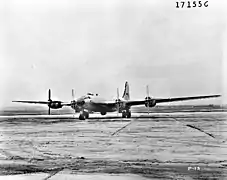1948 Lake Mead Boeing B-29 crash
The 1948 Lake Mead Boeing B-29 crash occurred 21 July 1948 when a Boeing B-29-100-BW Superfortress, modified into an F-13 reconnaissance platform and performing atmospheric research, crashed into the waters of Lake Mead, Nevada, US.
 An F-13 variant of the Boeing B-29 Superfortress, similar to the accident aircraft | |
| Accident | |
|---|---|
| Date | 21 July 1948 |
| Summary | Controlled flight into terrain (CFIT) due to pilot error |
| Site | Lake Mead, Nevada, US |
| Aircraft | |
| Aircraft type | Boeing F-13 Superfortress |
| Operator | United States Air Force |
| Registration | 45-21847 |
| Destination | Armitage Field (now NAWS China Lake), California |
| Passengers | 0 |
| Crew | 5 |
| Fatalities | 0 |
| Injuries | 0 |
| Survivors | 5 |
History
On 13 September 1945, “Lake Mead’s B-29,” serial number 45-21847, was put into service. In 1947 it was stripped of armaments, re-classified as a reconnaissance B-29 (F-13), and moved into the Upper Atmosphere Research Project. The purpose of this project was to develop an intercontinental ballistic missile guidance system that used the sun for direction and positioning. The system was known as "Sun Tracker", and to test it a plane capable of high-altitude flight followed by a rapid low-level flight was needed. The B-29 was a useful test platform as it was the first mass-produced aircraft with a pressurized cockpit, and after World War II there were many surplus B-29s available.[1]
On 21 July 1948, after completing a run to 30,000 feet (9,100 m) east of Lake Mead, Captain Robert M. Madison and the crew began a descent and leveled out just over 300 feet (91 m) above the surface of Lake Mead. The crew described the lake as looking like a mirror, with the sun reflecting brightly off the surface. These conditions make judging height above a surface considerably more difficult. The aircraft then slowly began to descend below 100 ft (30 m) until it struck the surface at 250 mph (400 km/h) and started skipping along it. Three of the aircraft's four engines were ripped from its wings and the fourth burst into flames. The aircraft managed to gain around 250 ft (76 m) but then settled back onto the water's surface in a nose-up attitude and slowly skiing to a stop. The five-man crew then evacuated into two liferafts and watched the aircraft sink.
The crew was rescued from the lake six hours later and was instructed not to disclose any details of the flight, its mission or its loss. As the mission was classified, these details were not released until fifty years later.[2]
Wreck
B-29 Serial No. 45-21847 (Heavy Bomber) | |
.jpg.webp) | |
| Nearest city | Overton, Nevada |
|---|---|
| NRHP reference No. | 11000212 |
| Added to NRHP | 20 April 2011 |
In 2001 a private dive team found the wreck of the B-29 in the Overton Arm of Lake Mead, using sidescan sonar. Because the bomber lay inside a National Recreation Area, responsibility for the site fell to the National Park Service.[3]
The bomber itself is listed on the National Register of Historic Places. In July 2007 the National Park Service started a six-month trial on the B-29 Lake Mead Overton site to private companies to conduct Guided Technical Dives. One company was Scuba Training and Technology Inc. / Tech Diving Limited based in Arizona. Despite being pleased with the overall preservation of the site by the two commercial use authorization (CUA) operations, the NPS closed the B-29 site for diving in 2008 for further conservation efforts.[1] In December 2014 NPS solicited applications for private dive companies to resume guided dive operations. Scuba Training and Technology Inc. / Tech Diving Limited was awarded the Commercial Use Authorization again and diving resumed beginning April 2015.[4] In 2017, the NPS closed the B-29 site for diving, for further conservation efforts. On May 30, 2019, the Park Service opened a public comment period (through June 30, 2019) to assess allowance of commercially guided trips to the site.[5]
References
- "B-29 Super Fortress Lake Mead National Recreation Area". Advanced Diver Magazine. 2008. Retrieved 2014-07-23.
- "The Mystery of Lake Mead". 8 News NOW. 2001-07-27. Retrieved 2020-07-11.
- "Dive Bomber". SMITHSONIAN MAGAZINE. October 2005. Retrieved 2014-07-23.
- "PERMIT AWARDED, DIVES RESUME ON B-29 SUBMERGED IN LAKE MEAD". www.nps.gov. U.S. National Park Service. Retrieved 29 November 2016.
- "Lake Mead National Recreation Area Seeks Public Comment Regarding Permitted Diving on The Submerged B-29 Aircraft". www.nps.gov. U.S. National Park Service. Retrieved 30 May 2019.
https://www.lasvegasscuba.com guided lake mead b-29 dives and Hoover Dam historical site dives